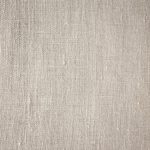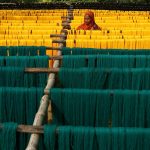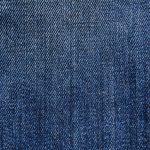You’ll find abaca fiber comes from the leaf stalks of a tropical plant native to the Philippines. It’s incredibly strong, lightweight, water-resistant, and biodegradable, making it perfect for sustainable textiles, ropes, and even automotive parts. Harvested carefully and processed with eco-friendly methods, abaca supports both local communities and the environment. Its versatility rivals hemp and jute, and its future applications keep expanding across industries. Explore further to discover how abaca could fit into your eco-conscious lifestyle and projects.
Table of Contents
Key Takeaways
- Abaca fiber is a strong, lightweight, and biodegradable textile derived from the leaf stalks of the abaca plant, native to the Philippines.
- Harvesting involves stripping mature leaf stalks, sun-drying fibers, and cleaning to produce eco-friendly, durable material with minimal waste.
- Traditionally used for ropes and crafts, abaca now serves in automotive parts, specialty papers, sustainable fashion, and eco-friendly packaging.
- Sustainable farming of abaca promotes biodiversity, soil health, and fair labor, with the fiber naturally decomposing without harmful residues.
- Future trends focus on automotive composites, green packaging, and construction materials, driven by rising demand for sustainable and biodegradable fibers.
What Is Abaca Fiber and Where Does It Come From?
Abaca fiber is a natural textile derived from the leaf stalks of the abaca plant, a species native to the Philippines.
When you harvest abaca, you strip the outer layers of the leaf stalk to reveal the long, strong fibers inside. These fibers are then extracted through a process called decortication, where the pulp is removed, leaving the durable strands you’ll use for various products.
The abaca plant thrives in tropical climates, especially in the Philippines’ humid regions, making it the world’s primary source of this fiber.
If you’re exploring sustainable textiles, knowing where abaca comes from and how it’s harvested helps you appreciate its natural origins and cultural significance in Filipino agriculture and craftsmanship.
Key Characteristics and Benefits of Abaca Fiber
You’ll find that the fibers extracted from the abaca plant offer unique qualities that set them apart from other natural textiles.
Abaca fiber is incredibly strong—stronger than hemp or jute—which makes it highly durable and resistant to wear and tear. It’s naturally water-resistant and quick-drying, so it’s less likely to rot or mildew if exposed to moisture.
You’ll also appreciate its lightweight nature combined with excellent flexibility, making it easy to work with for various applications. Plus, abaca is biodegradable and eco-friendly, so you’re choosing a sustainable material.
Its natural golden color requires minimal dyeing, reducing chemical use. These benefits make abaca fiber an outstanding choice when you want a sturdy, versatile, and environmentally responsible natural fiber.
Traditional and Modern Uses of Abaca Fiber
You’ll find abaca fiber woven into traditional crafts like ropes and mats, showcasing its sturdy nature.
Today, industries use it in products from paper to automotive parts, proving its versatility.
Plus, sustainable fashion brands are embracing abaca for eco-friendly textiles you can feel good about.
Traditional Craft Applications
Although it’s been used for centuries, this versatile fiber still holds a special place in traditional crafts today.
When you work with abaca fiber, you tap into a rich heritage of weaving and handcrafting that produces items like mats, ropes, and baskets. Its natural strength and flexibility make it perfect for creating durable, lightweight products that have stood the test of time.
You’ll find abaca woven into textiles that showcase intricate patterns passed down through generations, preserving cultural identity.
Additionally, artisans often use abaca in hat-making and paper crafting, blending functionality with artistry.
Contemporary Industrial Uses
While abaca fiber has deep roots in traditional crafts, its qualities have also caught the attention of modern industries. You’ll find abaca used in automotive components like seat covers and door panels, thanks to its strength and lightweight nature.
It’s also popular in making specialty paper products, such as tea bags and currency notes, because of its durability and resistance to wear. In construction, abaca reinforces composite materials, offering an eco-friendly alternative to synthetic fibers.
Even the packaging industry benefits from abaca’s biodegradability and toughness, making it ideal for sustainable packaging solutions. By choosing abaca, you’re tapping into a versatile, renewable resource that meets industrial demands without compromising on environmental responsibility.
Its combination of strength, flexibility, and biodegradability makes it a smart choice across various modern applications.
Sustainable Fashion Integration
Because abaca fiber blends durability with eco-friendliness, it’s becoming a favorite in sustainable fashion. You’ll find it used in both traditional garments and modern apparel, offering natural breathability and strength. Designers love that it supports eco-conscious practices while maintaining style and comfort. Whether you’re shopping for handcrafted bags or trendy shoes, abaca’s versatility shines.
Here’s a quick look at its uses:
| Traditional Uses | Modern Uses |
|---|---|
| Handwoven textiles | Sustainable footwear |
| Indigenous clothing | Eco-friendly accessories |
| Household fabrics | Fashion-forward bags |
How Abaca Fiber Is Harvested and Processed
When you harvest abaca fiber, timing and technique play crucial roles in guaranteeing the highest quality. You’ll want to cut the leaves when they’re mature, usually 8 to 12 months after planting.
Use a sharp knife to slice the leaf stalks close to the base. After cutting, you strip the outer layers to extract the fibers carefully.
Next, you’ll dry these fibers under the sun to reduce moisture content, which prevents mold and preserves strength.
Once dried, the fibers undergo a cleaning process where impurities are removed, sometimes by washing or beating.
Finally, you bundle the fibers for transport or further processing. By following these steps precisely, you guarantee the abaca fiber remains strong, flexible, and ready for high-quality textile or rope production.
Environmental Impact and Sustainability of Abaca Fiber
You’ll want to contemplate how abaca fiber’s eco-friendly production helps reduce waste and supports local ecosystems.
Its natural biodegradability means less environmental harm compared to synthetic fibers.
Let’s explore how these factors make abaca a sustainable choice.
Eco-Friendly Production Practices
Although abaca fiber production requires careful management, it offers a sustainable alternative to synthetic materials by relying on natural, renewable resources.
When you choose abaca, you support farming methods that minimize chemical use and promote soil health. Farmers often use organic fertilizers and practice crop rotation, which helps maintain the land’s fertility and prevents erosion.
The harvesting process is manual or low-impact, reducing energy consumption and pollution. Additionally, water usage in processing abaca fibers is optimized to avoid waste.
You’ll find that many producers focus on community-based approaches, ensuring fair labor practices and preserving local ecosystems.
Biodegradability and Waste Reduction
Building on eco-friendly production methods, abaca fiber also excels in biodegradability and waste reduction, making it a smart choice for sustainability.
When you use abaca, you’re choosing a material that naturally breaks down without leaving harmful residues, unlike synthetic fibers. This means less landfill waste and reduced environmental pollution.
Plus, the processing of abaca generates minimal waste since almost every part of the plant is utilized—from the fibers to the leaves. You can even compost leftover scraps, turning waste into valuable organic matter.
By opting for abaca fiber products, you actively contribute to closing the loop on material use, reducing your ecological footprint, and supporting a circular economy.
It’s a practical step toward greener living without sacrificing quality or durability.
Impact on Local Ecosystems
Because abaca cultivation integrates well with local ecosystems, it supports biodiversity and soil health in the regions where it grows.
When you choose abaca fiber, you’re endorsing a crop that positively impacts the environment in several ways:
- It prevents soil erosion by providing ground cover and stabilizing the soil with its root system.
- It requires minimal chemical inputs, reducing pollution and protecting nearby water sources.
- It creates habitats for various insects and wildlife, promoting biodiversity.
- It encourages sustainable farming practices, as farmers often intercrop abaca with other plants.
Comparing Abaca Fiber With Other Natural Fibers
When you compare abaca fiber to other natural fibers like jute, hemp, and sisal, you’ll notice its exceptional strength and flexibility set it apart. Abaca’s superior tensile strength makes it ideal for ropes and specialty paper, while its softness adds comfort not found in coarser fibers like sisal. You’ll also find abaca resists saltwater damage better than jute and hemp, making it perfect for marine uses.
| Fiber | Key Characteristics |
|---|---|
| Abaca | High strength, flexible, saltwater-resistant |
| Jute | Affordable, coarse, biodegradable |
| Hemp | Durable, mold-resistant, eco-friendly |
| Sisal | Stiff, abrasion-resistant, rough texture |
Choosing abaca means opting for a versatile, durable fiber suited to demanding applications.
Innovative Applications and Future Trends in Abaca Fiber Use
How is abaca fiber carving out new roles in modern industries? You’ll find it’s gaining traction beyond traditional uses, thanks to its strength and eco-friendliness.
Here are four innovative applications and future trends you should watch:
- Automotive Industry: Abaca composites are replacing synthetic fibers in car interiors, reducing weight and boosting sustainability.
- Packaging Solutions: Biodegradable abaca-based packaging is becoming popular as companies seek greener alternatives.
- Textile Innovation: Designers are integrating abaca into fashion, creating durable, breathable, and eco-conscious fabrics.
- Construction Materials: Abaca-reinforced panels and insulation materials offer natural strength and thermal benefits.
Frequently Asked Questions
How Do You Care for and Clean Abaca Fiber Products?
You should gently dust or vacuum abaca fiber products regularly. Avoid water and harsh chemicals; instead, spot clean with a damp cloth. Keep them away from direct sunlight to prevent fading and maintain their durability.
Can Abaca Fiber Cause Allergies or Skin Irritation?
Imagine soft, natural fibers brushing your skin gently; abaca fiber rarely causes allergies or irritation. However, if you have sensitive skin, you might experience mild reactions. Always test a small patch before full use to stay safe.
What Is the Average Lifespan of Abaca Fiber Textiles?
You can expect abaca fiber textiles to last around 5 to 10 years with proper care. Their natural strength resists wear, but exposure to moisture or rough use can shorten their lifespan considerably.
Are There Any Cultural Traditions Linked to Abaca Fiber Weaving?
When it comes to abaca weaving, you’ll find it’s more than just fiber; it’s deeply woven into Filipino culture. You’ll see traditions passed down generations, where weaving is the bread and butter of community identity and artistry.
How Does the Cost of Abaca Fiber Compare Globally?
You’ll find abaca fiber costs vary globally, often higher than synthetic fibers due to labor-intensive harvesting and processing. In regions where it’s abundant, prices are lower, but worldwide demand keeps costs relatively premium.
- The Ultimate Guide to Abaca Fiber: Everything You Need to Know - June 24, 2025
- What Is Abaca Fiber? the Complete Guide to “Manila Hemp” - June 24, 2025
- Troubleshooting: Why Your Acetate Garment Might Feel Weak or Tear Easily - June 24, 2025






